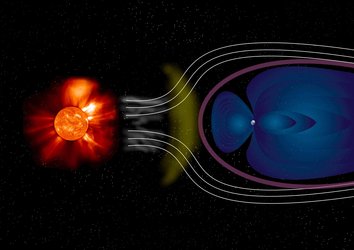Why are Power Systems important?
A reliable, ongoing power supply is essential to a space mission's success. The Sun provides around 1.4 kilowatts of power per square metre in Earth orbit - a bountiful resource that spacecraft designers do their very best to take advantage of. This is why the majority of spacecraft incorporate wing-like solar arrays or else have them layered across their hull.
These are composed of photovoltaic cells connected in a network, which produce an electrical current when light shines on them –working like the light emitting diodes of (LEDs), but in reverse. It is interesting to note that the technologies behind both solar cells and LEDs are very similar.
But this free availability of power does not mean designing a satellite's power system is an easy task. Photovoltaic cells efficiency reaches 30% for the latest designs but it is reduced by heating from the Sun and radiation damage during a satellite's lifetime. This means that solar arrays have to be of a significant size to deliver useful power levels (in the order of tens of square metres for a typical communications satellite).
Most satellites have orbits that will take them out of the Sun into shadow behind the Earth – for a low-Earth orbiting spacecraft that occurs once per orbit – so they are also equipped with rechargeable ('secondary') batteries to keep them powered in the meantime. These batteries are in general the only power source available just after launcher separation and until the solar generators are deployed and properly Sun pointed.
A satellite's electrical loads will often vary, depending on which instruments or subsystems are running at a particular time. One of the most important tasks of the power conditioning is therefore to control in an optimum way the exchanges of power between the solar generator, the battery and the loads. This means ensuring that the power delivered to the loads stays within the voltage range they can accept, sizing the solar array so that the battery can be replenished while the spacecraft equipment are supplied, ensuring that the battery will not experiment any excess charging current or voltage but also, in some exceptional anomalous situations, being able to disconnect some units (the so called non -essential ones) to avoid a battery full discharge and to safeguard the spacecraft.
The power system being a unique resource of the spacecraft, it has to be protected against failures of the supplied units that could degrade it or even take it out of service, especially short-circuits. This is exactly the same concern as in a house, where a centralised distribution panel hosts circuits breakers or fuses to eliminate uncontrolled current surges. Aboard a spacecraft both fuses or electronic circuit breakers are commonly used.















 Germany
Germany
 Austria
Austria
 Belgium
Belgium
 Denmark
Denmark
 Spain
Spain
 Estonia
Estonia
 Finland
Finland
 France
France
 Greece
Greece
 Hungary
Hungary
 Ireland
Ireland
 Italy
Italy
 Luxembourg
Luxembourg
 Norway
Norway
 The Netherlands
The Netherlands
 Poland
Poland
 Portugal
Portugal
 Czechia
Czechia
 Romania
Romania
 United Kingdom
United Kingdom
 Slovenia
Slovenia
 Sweden
Sweden
 Switzerland
Switzerland



























